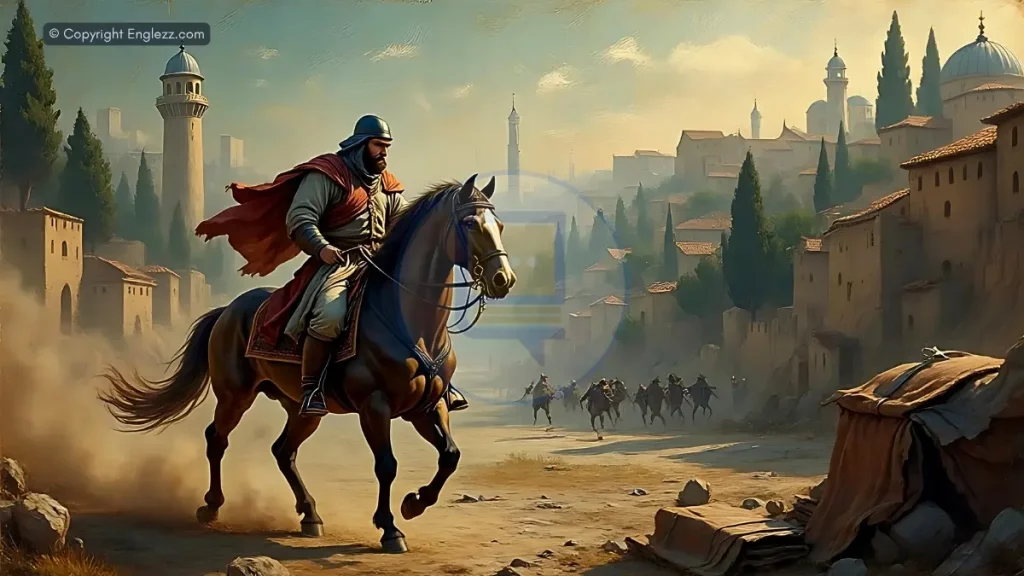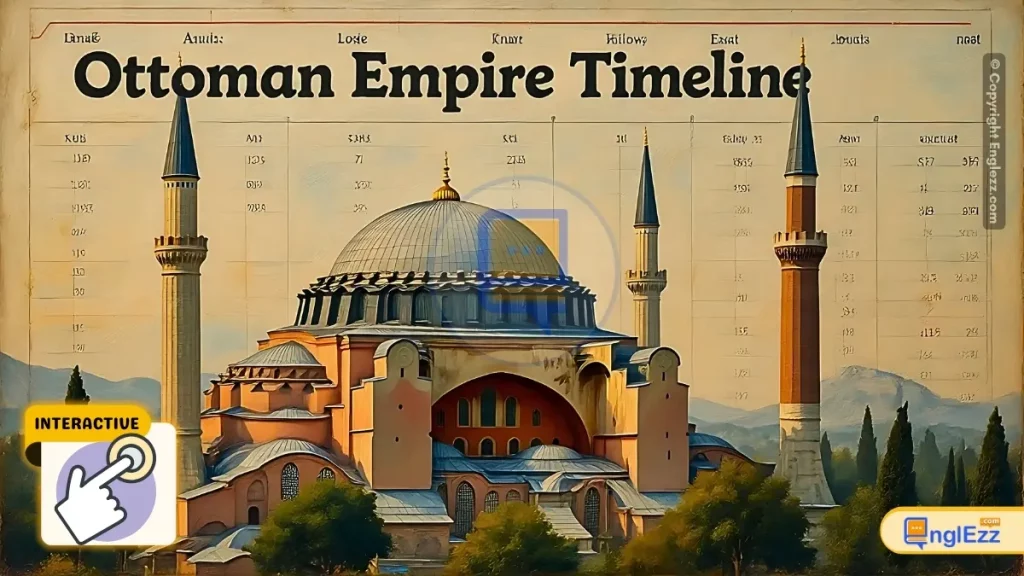
The Story of the Ottoman Empire
From Rise to Fall and Lasting Legacy
Introduction
The Ottoman Journey
The Ottoman Empire was one of the longest-lasting and most powerful empires in world history, spanning over six centuries from its foundation in 1299 to its dissolution in 1922. At its height, the empire controlled vast territories in Southeast Europe, Western Asia, and North Africa, encompassing diverse cultures, religions, and peoples.
The Ottomans excelled at military organization, architecture, law, and administration. They created a sophisticated system of government that incorporated elements from Byzantine, Persian, and Islamic traditions. The empire was known for its religious tolerance (especially under the millet system), magnificent architecture (like the works of Mimar Sinan), and its strategic control of key trade routes between Europe and Asia.
Rise of the Empire (1299-1453)
The early Ottoman period saw the transformation of a small Turkic principality into a regional power. Under Osman I and his successors, the Ottomans expanded across Anatolia and into the Balkans, culminating in the conquest of Constantinople in 1453 by Mehmed II, which marked the end of the Byzantine Empire.
Classical Age (1453-1566)
The Classical Age was the golden era of the Ottoman Empire, marked by the reigns of Suleiman the Magnificent and other powerful sultans. During this time, the empire reached its territorial peak, developed its distinctive institutions, and produced magnificent works of art and architecture.
Modern Legacy
After its dissolution following World War I, the Ottoman Empire gave way to the modern Republic of Turkey. However, its legacy continues in the cultural, architectural, and administrative traditions of numerous nations in the Middle East, North Africa, and Southeast Europe.
Interactive Ottoman Empire Timeline
Foundation of the Ottoman Empire
Osman I declares independence from the Seljuk Sultanate of Rum, marking the beginning of the Ottoman Empire.
Read moreIn 1299, Osman I, a Turkic tribal leader, declared independence from the declining Seljuk Sultanate of Rum in Anatolia. This marked the formal beginning of the Ottoman state, though it was then just a small principality in northwestern Anatolia.
Key aspects of the early Ottoman state:
- Ghazi ideology – holy warriors fighting for Islam
- Flexible administrative system incorporating Byzantine practices
- Strategic marriages and alliances with neighboring Turkic beyliks
- Early military successes against Byzantine forces
Osman’s successors would gradually expand this small state into a world empire over the next two centuries. The early Ottomans were skilled at adapting institutions from the civilizations they conquered while maintaining their Turkic and Islamic identity.
Further Reading
- Finkel, Caroline. Osman’s Dream: The History of the Ottoman Empire (2005)
- Imber, Colin. The Ottoman Empire, 1300-1650: The Structure of Power (2002)
Conquest of Constantinople
Mehmed II captures Constantinople, ending the Byzantine Empire and making it the new Ottoman capital.
Read moreOn May 29, 1453, after a 53-day siege, the 21-year-old Sultan Mehmed II (later known as “the Conqueror”) captured Constantinople, the capital of the Byzantine Empire. This marked one of the most significant events in world history:
- Ended the 1,500-year-old Byzantine Empire
- Established Istanbul (as it was renamed) as the new Ottoman capital
- Marked the Ottomans as a major world power
- Accelerated the Renaissance in Europe as Byzantine scholars fled west
Mehmed employed innovative tactics, including transporting ships overland to bypass the city’s sea defenses. The conquest gave the Ottomans control of the strategic Bosporus strait and a magnificent imperial capital that would be embellished by subsequent sultans.
Further Reading
- Crowley, Roger. 1453: The Holy War for Constantinople and the Clash of Islam and the West (2005)
- Runciman, Steven. The Fall of Constantinople 1453 (1965)
Suleiman the Magnificent’s Reign Begins
Suleiman I ascends to the throne, beginning the empire’s golden age.
Read moreSuleiman I (r. 1520-1566), known as “the Magnificent” in Europe and “the Lawgiver” in his realm, presided over the zenith of Ottoman power and cultural achievement. His reign marked the high point of the empire in terms of territorial expansion, administrative organization, and cultural flourishing.
Key achievements of Suleiman’s reign:
- Conquest of Belgrade (1521) and Rhodes (1522)
- Victory at Mohács (1526) leading to Ottoman control of Hungary
- Siege of Vienna (1529), though unsuccessful, demonstrated Ottoman reach
- Codification of Ottoman law (Kanun-name)
- Patronage of arts and architecture, including the works of Mimar Sinan
Suleiman’s reign also saw the rise of his wife Hürrem Sultan (Roxelana) as a powerful political figure, breaking with tradition by marrying her and allowing her to participate in state affairs.
Further Reading
- Clot, André. Suleiman the Magnificent (1992)
- Peirce, Leslie P. The Imperial Harem: Women and Sovereignty in the Ottoman Empire (1993)
Battle of Preveza
Ottoman navy under Hayreddin Barbarossa defeats the Holy League, securing Ottoman dominance in the Mediterranean.
Read moreThe Battle of Preveza (September 28, 1538) was a decisive naval engagement where the Ottoman fleet, commanded by the legendary admiral Hayreddin Barbarossa, defeated the combined forces of the Holy League (Spain, Venice, Genoa, and the Papal States) under Andrea Doria.
This victory:
- Established Ottoman naval supremacy in the Mediterranean for decades
- Secured Ottoman control over the eastern Mediterranean and North Africa
- Demonstrated the effectiveness of the Ottoman galley fleet
- Enhanced the reputation of Barbarossa as the greatest Ottoman admiral
The battle was part of Suleiman’s larger strategy to challenge Habsburg power in both the Mediterranean and Central Europe. Ottoman naval dominance would continue until the defeat at Lepanto in 1571, though they quickly rebuilt their fleet after that loss.
Further Reading
- Brummett, Palmira. Ottoman Seapower and Levantine Diplomacy in the Age of Discovery (1994)
- Capponi, Niccolò. Victory of the West: The Great Christian-Muslim Clash at the Battle of Lepanto (2006)
Siege of Vienna
The Ottoman defeat at Vienna marks the beginning of long-term territorial retreat in Europe.
Read moreThe failed Siege of Vienna (July-September 1683) marked a turning point in Ottoman fortunes. After nearly two months of siege, the Ottoman forces under Grand Vizier Kara Mustafa Pasha were defeated by a relief force led by Polish King Jan III Sobieski.
The defeat had significant consequences:
- Began the long retreat of Ottoman power from Central Europe
- Led to the loss of Hungary in subsequent wars
- Marked the end of Ottoman expansion into Europe
- Demonstrated growing European military superiority
- Led to the execution of Kara Mustafa Pasha on Sultan Mehmed IV’s orders
The battle became legendary in European history as the high-water mark of Ottoman expansion, though the empire remained a formidable power for another two centuries. The defeat prompted some early attempts at military reform within the empire.
Further Reading
- Stoye, John. The Siege of Vienna (1964)
- Wheatcroft, Andrew. The Enemy at the Gate: Habsburgs, Ottomans and the Battle for Europe (2008)
Treaty of Küçük Kaynarca
The treaty ends the Russo-Turkish War and marks Russia’s emergence as a major threat to Ottoman territories.
The Treaty of Küçük Kaynarca (July 21, 1774) ended the disastrous Russo-Turkish War of 1768-1774 and represented a major shift in the balance of power between the Ottoman Empire and Russia. Its terms were humiliating for the Ottomans:
- Russia gained territory north of the Black Sea
- The Crimean Khanate became independent (later annexed by Russia in 1783)
- Russia gained the right to protect Orthodox Christians in Ottoman lands
- The Ottomans paid a large war indemnity
- Russian merchant ships could sail freely in Ottoman waters
The treaty marked Russia’s emergence as a major Black Sea power and a growing threat to Ottoman territorial integrity. It also demonstrated the empire’s growing military and technological inferiority to European powers, prompting some early attempts at reform under Selim III (r. 1789-1807).
Further Reading
- Aksan, Virginia. Ottoman Wars 1700-1870: An Empire Besieged (2007)
- Quataert, Donald. The Ottoman Empire, 1700-1922 (2005)
Tanzimat Reforms Begin
The Gülhane Decree inaugurates the Tanzimat period of modernization and reform.
Read moreThe Tanzimat (Reorganization) period (1839-1876) was a series of reforms designed to modernize the Ottoman Empire and prevent its disintegration. The reforms were announced in the Gülhane Decree (November 3, 1839) by Sultan Abdülmecid I and his ministers, particularly Mustafa Reşid Pasha.
Key aspects of the Tanzimat reforms included:
- Modernization of the military along European lines
- Centralization of administration
- Legal reforms guaranteeing equality before the law for all subjects
- Land reform and new tax systems
- Educational reforms establishing modern schools
While the Tanzimat brought significant changes, it faced resistance from traditionalists and failed to prevent the empire’s continued territorial losses. However, it laid groundwork for later constitutional developments and influenced the modernization of other Middle Eastern states.
Further Reading
- Findley, Carter Vaughn. Bureaucratic Reform in the Ottoman Empire: The Sublime Porte, 1789-1922 (1980)
- Shaw, Stanford J., and Ezel Kural Shaw. History of the Ottoman Empire and Modern Turkey, Volume II (1977)
Abolition of the Sultanate
The Grand National Assembly of Turkey abolishes the sultanate, ending the Ottoman Empire.
Read moreOn November 1, 1922, the Grand National Assembly of Turkey, under Mustafa Kemal Atatürk’s leadership, abolished the Ottoman sultanate, ending 623 years of Ottoman rule. The last sultan, Mehmed VI, had already fled to Malta aboard a British warship on November 17.
This marked:
- The formal end of the Ottoman Empire
- The beginning of the Republic of Turkey (officially proclaimed October 29, 1923)
- The culmination of the Turkish War of Independence (1919-1922)
- The end of the caliphate (formally abolished in 1924)
The abolition followed the empire’s defeat in World War I and its occupation by Allied powers. The Turkish nationalist movement, led by Atatürk, rejected the postwar settlement and fought to establish an independent Turkish nation-state based on secular, modern principles rather than the multi-ethnic Ottoman model.
Further Reading
- Zürcher, Erik J. Turkey: A Modern History (2004)
- Mango, Andrew. Atatürk: The Biography of the Founder of Modern Turkey (1999)
Ottoman Empire Quiz
Test Your Knowledge of Ottoman History
Frequently Asked Questions
Common Questions About the Ottoman Empire
The Ottoman Empire rose from a small Turkic principality in northwestern Anatolia to a world empire through a combination of:
- Military innovation: Early adoption of gunpowder weapons and effective use of cavalry
- Strategic location: Control of key trade routes between Europe and Asia
- Political pragmatism: Incorporating conquered peoples into the administration
- Religious tolerance: The millet system allowed non-Muslim communities autonomy
- Weak neighbors: Taking advantage of Byzantine and Seljuk decline
The conquest of Constantinople in 1453 marked their emergence as a major world power, and under Suleiman the Magnificent (r. 1520-1566), the empire reached its territorial peak.
The devshirme (meaning “collection” or “gathering”) was a system of human tribute where Christian boys from the Balkans were taken by the Ottoman state, converted to Islam, and trained for imperial service. Key aspects included:
- Boys aged 8-20 were taken, typically every 5 years
- Most became Janissaries (elite soldiers), while the brightest could rise to high government positions
- The system provided the sultan with loyal servants not tied to noble families
- While traumatic for families, it offered social mobility for some Christian subjects
- The practice declined after the 17th century as Janissaries became hereditary
Many grand viziers and high officials came through this system, which was both feared as a form of oppression and seen by some as an opportunity.
The Ottoman Empire’s decline was a gradual process over centuries, caused by multiple factors:
- Military stagnation: Failure to keep pace with European military technology and tactics
- Economic challenges: Inflation from New World silver, loss of trade routes, and industrial backwardness
- Administrative corruption: The devshirme system decayed, and positions were sold
- Nationalist movements: Greek, Serbian, Bulgarian and other nationalisms eroded the multi-ethnic empire
- Geopolitical pressures: Simultaneous threats from Russia, Austria, and Persia
- Technological lag: Slow adoption of industrialization and modern transportation
Despite attempts at reform in the 19th century (Tanzimat, Young Turks), the empire couldn’t overcome these challenges and collapsed after World War I.
The Ottoman Empire left a profound legacy across its former territories:
- Cultural influence: Ottoman architecture, cuisine, and traditions persist in Turkey and the Balkans
- Political boundaries: Many modern Middle Eastern states emerged from Ottoman provinces
- Religious diversity: The millet system shaped relations between religious communities
- Legal systems: Ottoman law influenced later legal codes in the region
- Urban planning: Many cities still have Ottoman-era infrastructure and landmarks
- Demographics: Population movements during Ottoman rule affected ethnic distributions
The empire’s history continues to influence politics and identity debates in Turkey and throughout the former Ottoman world.
Conclusion
The Ottoman Legacy
The Ottoman Empire stands as one of history’s most remarkable political entities, bridging Europe and Asia for over six centuries. From its humble beginnings as a frontier principality to its zenith as a global power, and through its long decline and eventual transformation into modern Turkey, the empire left an indelible mark on world history.
While the empire is often remembered for its military conquests, its true significance lies in its ability to govern a remarkably diverse population across three continents, its contributions to art and architecture, and its role as a bridge between civilizations. The Ottoman experience offers valuable lessons about the challenges of governing multi-ethnic societies, the importance of institutional adaptability, and the complex interplay between tradition and modernization.
Ottoman Empire Key Takeaways
Rise to Power
The Ottomans emerged from a small Anatolian beylik to conquer Constantinople and establish a world empire through military innovation and strategic alliances.
Golden Age
The 16th century under Suleiman the Magnificent represented the empire’s peak in territorial extent, administrative sophistication, and cultural achievement.
Long Decline
Military defeats, economic challenges, and nationalist movements gradually eroded Ottoman power over three centuries of decline.
Modern Transformation
Reform efforts and eventual collapse gave way to the modern Republic of Turkey, while Ottoman legacies endure across the Middle East and Balkans.
The study of the Ottoman Empire reminds us that civilizations are not static but constantly evolving, adapting to new challenges while preserving elements of their heritage. As we grapple with many of the same issues the Ottomans faced—managing diversity, balancing tradition with modernity, and navigating geopolitical rivalries—their history offers both cautionary tales and inspiring examples.
Recommended Reading About the Ottoman Empire
- Finkel, Caroline. Osman’s Dream: The History of the Ottoman Empire (2005)
- Imber, Colin. The Ottoman Empire, 1300-1650: The Structure of Power (2002)
- Quataert, Donald. The Ottoman Empire, 1700-1922 (2005)
- Şahin, Kaya. Empire and Power in the Reign of Süleyman: Narrating the Sixteenth-Century Ottoman World (2013)
- Zürcher, Erik J. Turkey: A Modern History (2004)









